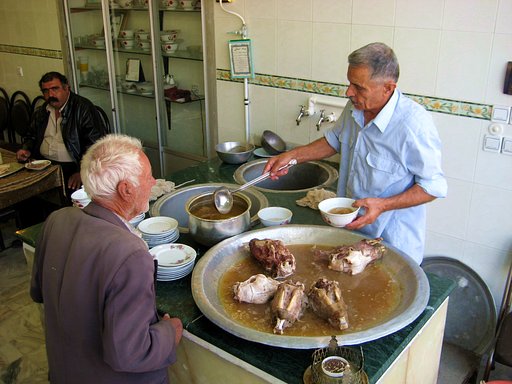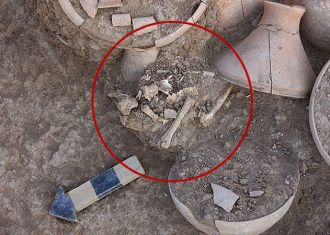November 29 2013

A team of Iranian and Italian archaeologists has found the bones of sheep heads and hooves in two bowls buried in two graves about 4,000 years ago, indicating that the grand Persian breakfast dish of kaleh pacheh has a very long pedigree indeed.
The remains of the dish were unearthed during the latest excavation at a site located near the town of Sankhast in Khorasan North province, the Iranian director of the team, Ali-Akbar Vahdati, told Cultural Heritage News.
“Remains of a sheep’s head and four hooves have been found in two bowl-shaped containers buried in the graves with the bodies of two persons,” he said.
“This discovery shows that kaleh pacheh was likely their favorite food that was presented to them after their deaths,” he explained.
Kaleh pacheh—literally heads and hooves—is a popular breakfast dish in modern Iran. It is served at kaleh pacheh houses that dot Iranian cities and open in the pre-dawn hours. The dish, however, is facing some criticism in nutrition and medical circles as being high in bad cholesterol. Many in the younger generation also seem turned off by the dish.
The heads and hooves of sheep are steamed over giant pots of water. Customers strip the meat off the skulls and feet and get a bowl of the broth the steaming produces along with bread that diners tear up and use to soak up the broth. The brain, eyes and tongue of the sheep add to the delicacy.
At the Ali 110 restaurant in Tehran, The Washington Post reporter in Iran some years ago savored kaleh pacheh with Ali Lamei, a 27-year-old interior designer. Having first sprinkled the remains of an eye with salt and drops of lemon juice, Lamei stuck it between a piece of bread and offered it to his guest, as Iranian etiquette prescribes.
“This place is the best kaleh pacheh restaurant in the whole of Iran,” Lamei said. “Some young people and women think it’s disgusting, but it’s full of calories,” he explained. “This food gives you enough energy to work the whole day.”
The sheep skulls stripped of meat that greet diners entering a kaleh pacheh house also turn off some urban visitors.
The details of how the heads and hooves were savored 4,000 years ago could not be divined from the remains in the tombs, but the fact that kaleh pacheh was placed in the graves suggested the Iranians of 4,000 years ago felt just like Lamei.
This is the second season of excavation the Iranian-Italian team has carried out at the site where the kaleh pacheh residue was found. The first season was completed in 2011. The team includes Italian archaeologist Rafael Bichone and his colleagues from Italy’s Institute for Aegean and Near Eastern Studies (ICEVO).
They have discovered 14 graves in 14 trenches dug at the site.

“Earthenware dishes, which had been filled with foods, have been discovered in the graves. The archaeologists have also found remains of goat and sheep meat in some of the dishes,” Vahdati said.
During this season of excavation, the archaeologists said that they found traces of an international culture similar to the BMAC or Bactria-Margiana Archaeological Complex.
The BMAC, also known as the Oxus civilization, is the modern archaeological designation for a Bronze Age civilization found in Central Asia. The civilization, which dates to roughly 2300–1700 BCE, was located in present day northern Afghanistan, eastern Turkmenistan, southern Uzbekistan and western Tajikistan, centered on the upper Amu Darya (Oxus River).
“All the artifacts unearthed from the graves [in Khorasan North] have the same characteristics identified with the BMAC in Central Asia,” Vahdati said, indicating the civilization prevailed farther south than previously known.
